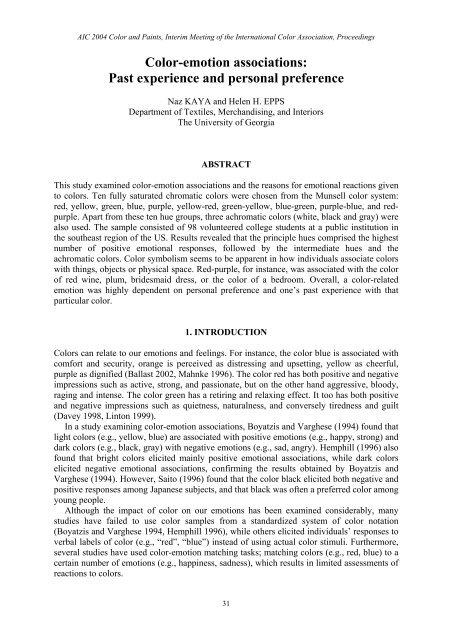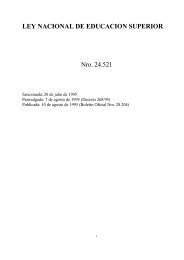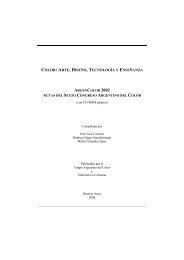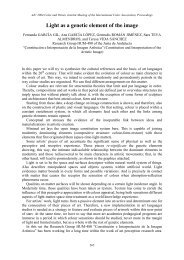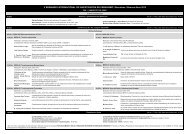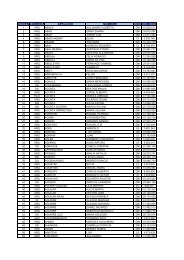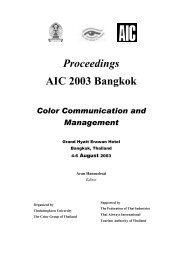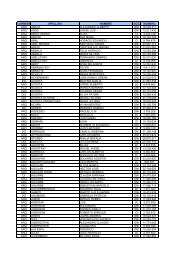Color-emotion associations: Past experience and personal preference
Color-emotion associations: Past experience and personal preference
Color-emotion associations: Past experience and personal preference
Create successful ePaper yourself
Turn your PDF publications into a flip-book with our unique Google optimized e-Paper software.
AIC 2004 <strong>Color</strong> <strong>and</strong> Paints, Interim Meeting of the International <strong>Color</strong> Association, Proceedings<br />
<strong>Color</strong>-<strong>emotion</strong> <strong>associations</strong>:<br />
<strong>Past</strong> <strong>experience</strong> <strong>and</strong> <strong>personal</strong> <strong>preference</strong><br />
Naz KAYA <strong>and</strong> Helen H. EPPS<br />
Department of Textiles, Merch<strong>and</strong>ising, <strong>and</strong> Interiors<br />
The University of Georgia<br />
ABSTRACT<br />
This study examined color-<strong>emotion</strong> <strong>associations</strong> <strong>and</strong> the reasons for <strong>emotion</strong>al reactions given<br />
to colors. Ten fully saturated chromatic colors were chosen from the Munsell color system:<br />
red, yellow, green, blue, purple, yellow-red, green-yellow, blue-green, purple-blue, <strong>and</strong> redpurple.<br />
Apart from these ten hue groups, three achromatic colors (white, black <strong>and</strong> gray) were<br />
also used. The sample consisted of 98 volunteered college students at a public institution in<br />
the southeast region of the US. Results revealed that the principle hues comprised the highest<br />
number of positive <strong>emotion</strong>al responses, followed by the intermediate hues <strong>and</strong> the<br />
achromatic colors. <strong>Color</strong> symbolism seems to be apparent in how individuals associate colors<br />
with things, objects or physical space. Red-purple, for instance, was associated with the color<br />
of red wine, plum, bridesmaid dress, or the color of a bedroom. Overall, a color-related<br />
<strong>emotion</strong> was highly dependent on <strong>personal</strong> <strong>preference</strong> <strong>and</strong> one’s past <strong>experience</strong> with that<br />
particular color.<br />
1. INTRODUCTION<br />
<strong>Color</strong>s can relate to our <strong>emotion</strong>s <strong>and</strong> feelings. For instance, the color blue is associated with<br />
comfort <strong>and</strong> security, orange is perceived as distressing <strong>and</strong> upsetting, yellow as cheerful,<br />
purple as dignified (Ballast 2002, Mahnke 1996). The color red has both positive <strong>and</strong> negative<br />
impressions such as active, strong, <strong>and</strong> passionate, but on the other h<strong>and</strong> aggressive, bloody,<br />
raging <strong>and</strong> intense. The color green has a retiring <strong>and</strong> relaxing effect. It too has both positive<br />
<strong>and</strong> negative impressions such as quietness, naturalness, <strong>and</strong> conversely tiredness <strong>and</strong> guilt<br />
(Davey 1998, Linton 1999).<br />
In a study examining color-<strong>emotion</strong> <strong>associations</strong>, Boyatzis <strong>and</strong> Varghese (1994) found that<br />
light colors (e.g., yellow, blue) are associated with positive <strong>emotion</strong>s (e.g., happy, strong) <strong>and</strong><br />
dark colors (e.g., black, gray) with negative <strong>emotion</strong>s (e.g., sad, angry). Hemphill (1996) also<br />
found that bright colors elicited mainly positive <strong>emotion</strong>al <strong>associations</strong>, while dark colors<br />
elicited negative <strong>emotion</strong>al <strong>associations</strong>, confirming the results obtained by Boyatzis <strong>and</strong><br />
Varghese (1994). However, Saito (1996) found that the color black elicited both negative <strong>and</strong><br />
positive responses among Japanese subjects, <strong>and</strong> that black was often a preferred color among<br />
young people.<br />
Although the impact of color on our <strong>emotion</strong>s has been examined considerably, many<br />
studies have failed to use color samples from a st<strong>and</strong>ardized system of color notation<br />
(Boyatzis <strong>and</strong> Varghese 1994, Hemphill 1996), while others elicited individuals’ responses to<br />
verbal labels of color (e.g., “red”, “blue”) instead of using actual color stimuli. Furthermore,<br />
several studies have used color-<strong>emotion</strong> matching tasks; matching colors (e.g., red, blue) to a<br />
certain number of <strong>emotion</strong>s (e.g., happiness, sadness), which results in limited assessments of<br />
reactions to colors.<br />
31
AIC 2004 <strong>Color</strong> <strong>and</strong> Paints, Interim Meeting of the International <strong>Color</strong> Association, Proceedings<br />
The purpose of this study was to examine college students’ color-<strong>emotion</strong> <strong>associations</strong>,<br />
referencing color samples from the st<strong>and</strong>ardized Munsell color system <strong>and</strong> to investigate the<br />
reasons for students’ <strong>emotion</strong>al reactions to each color.<br />
2. METHOD<br />
Ninety-eight volunteered college students (44 men <strong>and</strong> 54 women) participated in the study.<br />
They were asked to indicate their <strong>emotion</strong>al responses to five principle hues (i.e., red, yellow,<br />
green, blue, purple), five intermediate hues (i.e., yellow-red, green-yellow, blue-green, purpleblue,<br />
<strong>and</strong> red-purple), <strong>and</strong> three achromatic colors (white, gray, <strong>and</strong> black) <strong>and</strong> the reasons for<br />
their choices. The Munsell notations are shown in Table 1.<br />
Table 1. Munsell notations.<br />
<strong>Color</strong> Munsell<br />
Red 5R 5/14<br />
Yellow 7.5Y 9/10<br />
Green 2.5G 5/10<br />
Blue 10B 6/10<br />
Purple 5P 5/10<br />
Yellow-red 5YR 7/12<br />
Green-yellow 2.5GY 8/10<br />
Blue-green 5BG 7/8<br />
Purple-blue 7.5PB 5/12<br />
Red-purple 10RP 4/12<br />
White N/9<br />
Gray N/5<br />
Black N/1<br />
The color samples were prepared by using Freeh<strong>and</strong> 10.0 software, in which Munsell color<br />
notations were available in that computer program. Each color sample (10 cm × 12 cm) was<br />
displayed in the middle of the computer screen one at a time. Order of presentation of the<br />
color samples was r<strong>and</strong>omized across participants. Students were allowed to state only one<br />
<strong>emotion</strong>al response for each color. Each experimental session lasted for about ten minutes.<br />
3. RESULTS<br />
Based on the results obtained from the students’ responses, the color green attained the<br />
highest number of positive <strong>emotion</strong>s (95.9%), including the feelings of relaxation, followed<br />
by happiness, comfort, peace, <strong>and</strong> hope. Green was associated with nature <strong>and</strong> trees, <strong>and</strong> thus<br />
creating feelings of comfort <strong>and</strong> soothing <strong>emotion</strong>s. The color yellow was generally seen to be<br />
energetic <strong>and</strong> elicited positive <strong>emotion</strong>s (93.9%) including happiness <strong>and</strong> excitement because<br />
it was associated with the sun <strong>and</strong> summer time. The next highest number of positive response<br />
was given for the color blue (79.6%), followed by red <strong>and</strong> purple (64.3% each). Blue was<br />
associated with the ocean or the sky <strong>and</strong> thus inducing relaxing <strong>and</strong> calming effect. The color<br />
red was associated not only with love <strong>and</strong> romance, but with evil <strong>and</strong> blood. One respondent<br />
said that the color red reminded her of Valentine’s Day <strong>and</strong> the shape of heart. Another said<br />
that the color reminds her of red lingerie. The positive aspects of purple are tended to be<br />
32
AIC 2004 <strong>Color</strong> <strong>and</strong> Paints, Interim Meeting of the International <strong>Color</strong> Association, Proceedings<br />
mainly associated with children <strong>and</strong> laughing, while reasons given for negative responses to<br />
purple consistently showed that purple was not a favorite color.<br />
Among the intermediate hues, the blue-green elicited the highest number of positive<br />
responses (81.6%), followed by red-purple (76.5%), yellow-red (75.4%), <strong>and</strong> purple-blue<br />
(65.3%). On the contrary, the color green-yellow elicited the highest number (71.4%) of<br />
negative <strong>emotion</strong>al responses because it elicited the feelings of sickness <strong>and</strong> disgust.<br />
For the achromatic colors, white attained a large number of positive responses (61.2%),<br />
compared with only 19.4% <strong>and</strong> 7.1% positive responses for the colors black <strong>and</strong> gray,<br />
respectively. White was associated with the feelings of innocence, peace, <strong>and</strong> hope because it<br />
reminded some respondents of bride, snow, dove, <strong>and</strong> cotton. Reasons given for negative<br />
<strong>emotion</strong>al responses to white showed that white elicited the feelings of loneliness <strong>and</strong><br />
boredom. The color black was also evoked negative <strong>emotion</strong>s such as depression, fear, <strong>and</strong><br />
anger because it was associated with mourning <strong>and</strong> tragic events. The positive aspects of<br />
black were richness, wealth, <strong>and</strong> power. It also reminded some respondents of tuxedos <strong>and</strong><br />
formal gowns. Reasons given for negative <strong>emotion</strong>al responses to gray showed that the color<br />
gray tends to refer to bad weather <strong>and</strong> brings out the feelings of sadness, depression, <strong>and</strong><br />
boredom.<br />
4. DISCUSSION<br />
<strong>Color</strong> symbolism can be apparent in how individuals associate colors with things, objects or<br />
physical space. For instance, in the present study, the color yellow-red was associated with the<br />
color of autumn or Halloween. One respondent said that yellow-red made her happy because<br />
it reminded her of school buses <strong>and</strong> her childhood. Furthermore, the color blue-green was<br />
associated not only with the ocean <strong>and</strong> the sky, but also reminded some respondents of cool<br />
mints <strong>and</strong> toothpaste. Some associated black with “power,” <strong>and</strong> said it reminded them of nice<br />
sport cars. Black made some respondents feel sophisticated <strong>and</strong> reminded them of “fashion<br />
<strong>and</strong> clothing”. Yet, another respondent said the color black made him sad <strong>and</strong> reminded him<br />
of “funerals where people wear black”. Therefore, a color-related <strong>emotion</strong> is highly dependent<br />
on <strong>personal</strong> <strong>preference</strong> <strong>and</strong> one’s past <strong>experience</strong> with that particular color. A replication of<br />
this study at different institutions could give us a more comprehensive underst<strong>and</strong>ing of the<br />
issues raised here. Cross-site studies could be conducted to identify similar or different<br />
patterns in students’ <strong>emotion</strong>al <strong>associations</strong> to colors.<br />
Moreover, color conventions differ from one society to another. A well-known example is<br />
with the two achromatic colors; black <strong>and</strong> white. Death <strong>and</strong> mourning are associated with the<br />
color black in Western traditions, whereas in China the color of death is white. In the present<br />
study, the color black was associated not only with royalty, power, <strong>and</strong> wealth, but with death,<br />
mourning, <strong>and</strong> tragic events. Cross-cultural research could shed light on these issues by<br />
determining how cultural differences vary in color-<strong>emotion</strong> <strong>associations</strong>.<br />
ACKNOWLEDGMENT<br />
This study was supported by a research grant from the College of Family <strong>and</strong> Consumer<br />
Sciences at the University of Georgia.<br />
33
AIC 2004 <strong>Color</strong> <strong>and</strong> Paints, Interim Meeting of the International <strong>Color</strong> Association, Proceedings<br />
REFERENCES<br />
Ballast, D. K. 2002. Interior design reference manual. Belmont, CA: Professional Pub.<br />
Boyatzis, C. J., <strong>and</strong> R. Varghese. 1994. Children’s <strong>emotion</strong>al <strong>associations</strong> with colors. Journal of<br />
Genetic Psychology 155: 77-85.<br />
Davey, P. 1998. True colors: The glorious polychromy of the past suggests a strong historical need for<br />
color, despite current reductive fashions. The Architectural Review 204: 34-36.<br />
Hemphill, M. 1996. A note on adults’ color-<strong>emotion</strong> <strong>associations</strong>. Journal of Genetic Psychology 157:<br />
275-281.<br />
Linton, H. 1999. <strong>Color</strong> in architecture: Design methods for buildings, interiors <strong>and</strong> urban spaces.<br />
New York: McGraw Hill.<br />
Mahnke, F. 1996. <strong>Color</strong>, environment, human response. New York: Van Nostr<strong>and</strong> Reinhold.<br />
Saito, M. 1996. Comparative studies on color <strong>preference</strong> in Japan <strong>and</strong> other Asian regions, with<br />
special emphasis on the <strong>preference</strong> for white. <strong>Color</strong> Research <strong>and</strong> Application 21 (1): 35-49.<br />
Address: Naz Kaya, Department of Textiles, Merch<strong>and</strong>ising <strong>and</strong> Interiors<br />
307 Dawson Hall, The University of Georgia, Athens GA 30602, USA<br />
E-mails:<br />
34


